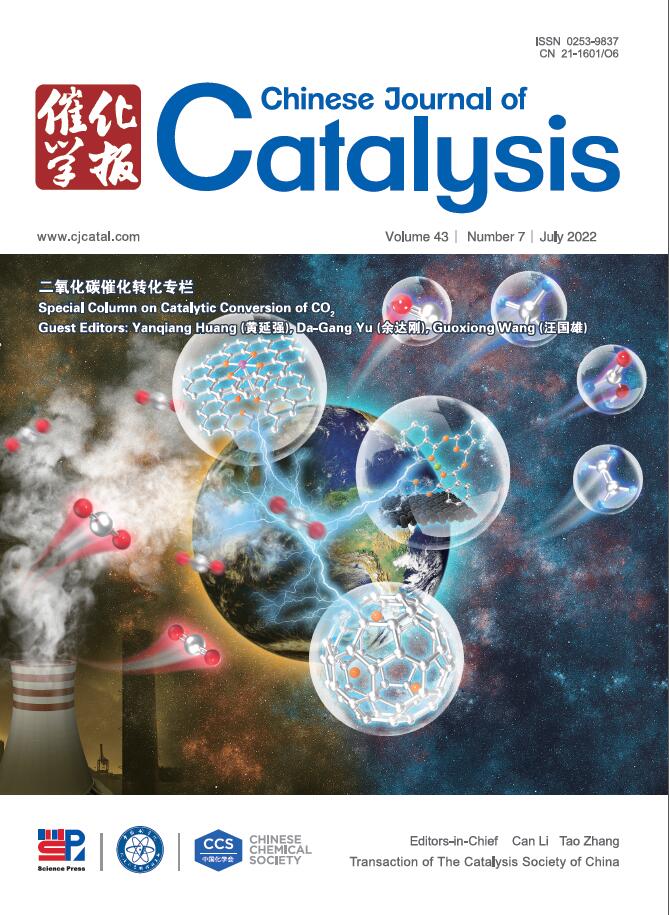Asymmetric synthesis of chiral N-substituted amino amides and esters with two chiral centers by imine reductase-catalyzed dynamic kinetic resolution via reductive amination
IF 17.7
1区 化学
Q1 CHEMISTRY, APPLIED
引用次数: 0
Abstract
Chiral N-substituted amino amides and esters are ubiquitous scaffolds in pesticides and pharmaceutical chemicals, but their asymmetric synthesis remains challenging especially for those with multiple chiral centers. In this study, IR104 from Streptomyces aureocirculatus was identified from 157 wild-type imine reductases for the synthesis of (S)-2-((R)-2-oxo-4-propylpyrrolidin-1-yl) butanamide (antiepileptic drug Brivaracetam) via dynamic kinetic resolution reductive amination from ethyl 3-formylhexanoate and (S)-2-aminobutylamide with high diastereoselectivity. To further improve the catalytic efficiency of IR104, its mutant D191E/L195I/E253S/M258A (M3) was identified by saturation mutagenesis and iterative combinatorial mutagenesis, which exhibited a 102-fold increase in the catalytic efficiency relative to that of wild-type enzyme and high diastereoselectivity (98:2 d.r.). Crystal structural analysis and molecular dynamics simulations provided some insights into the molecular basis for the improved activity of the mutant enzyme. The imine reductase identified in this study could accept chiral amino amides/esters as amino donors for the dynamic kinetic resolution reductive amination of racemic α-substituted aldehydo-esters, expanding the substrate scope of imine reductases in the dynamic kinetic resolution-reductive amination. Finally, IR104-M3 was successfully used for the preparation of Brivaracetam at gram scale. Using this mutant, various N-substituted amino amides/esters with two chiral centers were also synthesized with up to 99:1 d.r. and 96% yields and subsequently converted into γ- and δ-lactams, providing an efficient protocol for the synthesis of these important compounds via enzymatic dynamic kinetic resolution-reductive amination from simple building blocks.
亚胺还原酶催化还原胺化动力学拆分不对称合成手性n取代氨基酰胺及双手性中心酯
手性n取代氨基酰胺和酯是农药和医药化学品中普遍存在的支架材料,但它们的不对称合成仍然具有挑战性,特别是对于具有多个手性中心的材料。本研究从157个野生型亚胺还原酶中鉴定出来自小环链霉菌的IR104,通过高非对映选择性的3-甲酰基己酸乙酯和(S)-2-氨基丁酰胺的动态拆分还原胺化反应合成(S)-2-((R)-2-氧-4-丙基吡啶-1-基)丁酰胺(抗癫痫药布伐西坦)。为了进一步提高IR104的催化效率,通过饱和诱变和迭代组合诱变鉴定了其突变体D191E/L195I/E253S/M258A (M3),其催化效率比野生型酶提高了102倍,且具有较高的非对位选择性(98:2 d.r)。晶体结构分析和分子动力学模拟为突变酶活性的提高提供了一些分子基础的见解。本研究发现的亚胺还原酶可以接受手性氨基酰胺/酯作为氨基给体,进行外消旋α-取代醛酯的动态动力学分辨还原胺化反应,扩大了亚胺还原酶在动态动力学分辨还原胺化反应中的底物范围。最后,IR104-M3成功用于克级布伐西坦的制备。利用该突变体,多种具有两个手性中心的n取代氨基酰胺/酯也以高达99:1的dr和96%的产率合成,随后转化为γ-和δ-内酰胺,为通过酶的动态动力学分解-还原胺化从简单的构建块合成这些重要化合物提供了有效的方案。
本文章由计算机程序翻译,如有差异,请以英文原文为准。
求助全文
约1分钟内获得全文
求助全文
来源期刊

Chinese Journal of Catalysis
工程技术-工程:化工
CiteScore
25.80
自引率
10.30%
发文量
235
审稿时长
1.2 months
期刊介绍:
The journal covers a broad scope, encompassing new trends in catalysis for applications in energy production, environmental protection, and the preparation of materials, petroleum chemicals, and fine chemicals. It explores the scientific foundation for preparing and activating catalysts of commercial interest, emphasizing representative models.The focus includes spectroscopic methods for structural characterization, especially in situ techniques, as well as new theoretical methods with practical impact in catalysis and catalytic reactions.The journal delves into the relationship between homogeneous and heterogeneous catalysis and includes theoretical studies on the structure and reactivity of catalysts.Additionally, contributions on photocatalysis, biocatalysis, surface science, and catalysis-related chemical kinetics are welcomed.
 求助内容:
求助内容: 应助结果提醒方式:
应助结果提醒方式:


